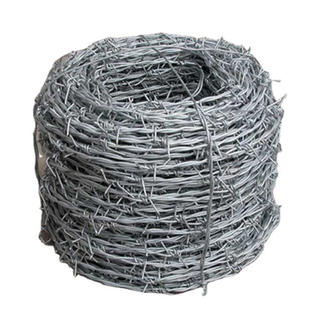Barbed Wire is a specialized fencing wire constructed with sharp edges or points arranged at intervals along the strand. Typically made from galvanized steel for corrosion resistance, it serves as an effective deterrent for containing livestock and enhancing security. The barbs, either twisted or clipped onto the wire, create a psychological and physical barrier that prevents animals or intruders from crossing.
Widely used in agricultural, military, and security applications, barbed wire is essential for ranch fencing, perimeter protection, and border control. Its simple yet efficient design provides a cost-effective solution for large-area enclosures while requiring minimal maintenance. Modern variations include high-tensile versions for greater durability and coated options for extended weather resistance.
Though primarily functional, barbed wire's historical significance in territorial demarcation and warfare underscores its strategic importance. Today, it remains indispensable in rural and high-security settings where reliable, long-lasting barriers are needed. Its balance of affordability and effectiveness ensures continued relevance across various protective applications.
What was barbed wire used for?
Barbed wire was originally developed in the 19th century as a cost-effective solution for fencing large areas of land, particularly in the American West. Its primary purpose was to contain livestock, such as cattle and sheep, by creating a physical barrier that deterred animals from crossing due to its sharp, protruding barbs. Beyond agriculture, barbed wire quickly became a strategic tool in warfare, used to fortify trenches and defensive positions during conflicts like World War I. It also served as a perimeter security measure for prisons, military bases, and private property, preventing unauthorized access. The invention of barbed wire revolutionized land management by replacing expensive wooden fences and enabling the efficient enclosure of vast open plains. Today, it remains widely used in farming, security, and even wildlife control, proving its enduring practicality.
Can barbed wire be electrified?
Yes, barbed wire can be electrified to enhance its effectiveness as a deterrent. When connected to an energizer or electric fence charger, the wire delivers a non-lethal but memorable shock to anyone or anything that comes into contact with it. This is commonly used in agricultural settings to prevent livestock from pushing against or escaping through fences, as well as in high-security areas to discourage intruders. Electrified barbed wire requires proper insulation on supporting posts and regular maintenance to ensure consistent voltage. While it significantly improves security, local regulations often govern its use due to safety concerns. When installed correctly, electrified barbed wire provides a powerful psychological and physical barrier, making it a popular choice for both farmers and security professionals.
How durable is barbed wire?
Barbed wire is highly durable, designed to withstand harsh environmental conditions and physical stress. Typically made from galvanized steel or stainless steel, it resists rust and corrosion, ensuring a long lifespan even in wet or humid climates. The tensile strength of the wire allows it to endure animal pressure, wind, and minor impacts without breaking. High-quality barbed wire can last 20–30 years with minimal maintenance, though exposure to extreme weather or mechanical damage may reduce its longevity. Regular inspections and occasional repairs, such as tightening loose strands or replacing damaged sections, help maintain its effectiveness. Its durability, combined with low cost and ease of installation, makes barbed wire a reliable choice for long-term fencing solutions in agriculture, security, and industrial applications.


